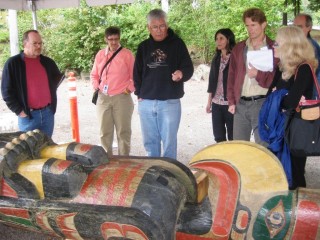This content was published: September 16, 2010. Phone numbers, email addresses, and other information may have changed.
Richard Hunt returns to PCC to restore totem pole
Photos and story by Kate Chester
Native artist and carver Richard Hunt explains his restoration work to Sylvania Campus’ cedar totem pole –“The Welcome Pole” – to a handful of PCC art instructors during Inservice Week.

Native artist and carver Richard Hunt explains his restoration work to Sylvania staff.
Hunt – a member of the Kwa-gulth (Kwaikiutl) Nation in British Columbia – carved and installed the totem pole at Sylvania about a decade earlier, in the outdoor grove of trees on the north side of campus.
Hunt traveled to PCC during in-service week to patch the holes created by woodpeckers. Read more about when Hunt first visited the campus to carve the pole and help install it above the library and about the plans PCC had when he arrived. The installation a decade ago was led by former PCC art instructor Marie Watt (member of the Seneca Nation), who served as totem pole committee chair.
Hunt, 60, was born in Alert Bay, B.C. and works out of his studio near Victoria on Vancouver Island. He began carving at the age of 13, mentored by his father Henry. In 1973, Richard began working at the Royal British Columbia Museum as an apprentice carver under his father and the following year he assumed the duties as chief carver in the Thunderbird Park Carving program.
He remained in that position for the next 12 years until he left to build a career as a full-time artist in 1986.Hunt quickly became the third artist from the Hunt family, his grandfather Mungo and his father the first two, to become internationally recognized and in 1991 received the prestigious “The Order of Canada” Award. He said he developed the idea for the PCC totem pole from the Hunt family crestpole, which incorporates such figures as the eagle, bear, man and salmon.
